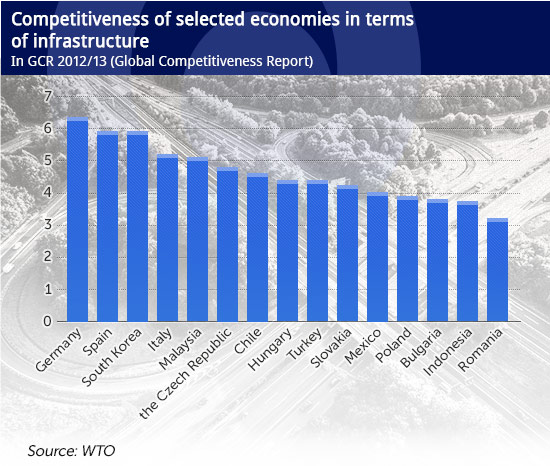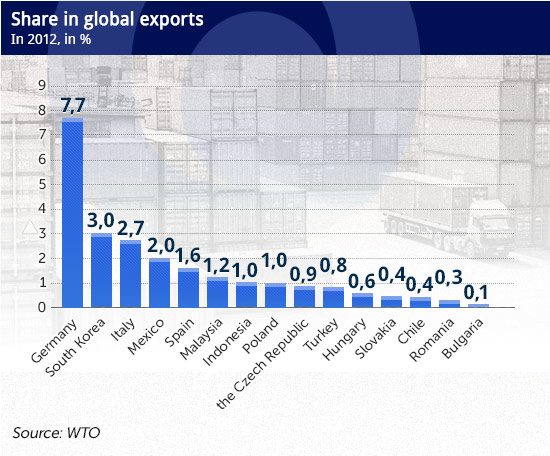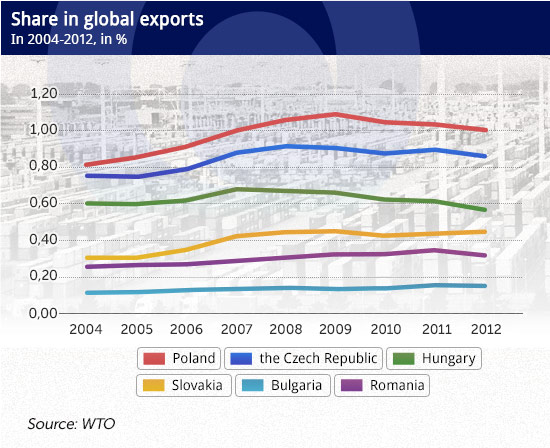Tydzień w gospodarce
Category: Trendy gospodarcze

President Bronisław Komorowski invited economists who did not contribute to the study entitled “How to advance in the world league? Report on the competitiveness of the economy” to express their opinion thereon. The document will be presented at the beginning of next week at the Fourth Innovative Economy Congress.
>> Read also: Interview with Professor Jerzy Hausner, the author of the report
The report points out that we are caught up in current problems and manage to deal with the challenges of the economic situation, but we fail to consider deeper, structural problems. Poland’s economic development has been driven by imitative innovation, foreign capital, cheap labour and, consequently, we have fallen into the trap of medium-level income.
Over time, the drawbacks of this model of economic growth have became apparent: the progressive de-industrialization, lower quality of human capital following the emigration of the most industrious citizens, the lack of investment in education, or – to put it more broadly – in human capital, and plummeting levels of household savings. This state of affairs condemns our economy to imitation rather than creativity.
According to the study’s authors, the Polish economy is now at a turning point. Its growth has thus far been associated with a large influx of foreign capital, which guaranteed export growth. It was also due to household consumption growth, which in turn was the consequence of limited incentives to save and of mounting household debts.
It will no longer be possible to follow this path. We will either lose the existing competitive advantage of low costs (especially labour costs), resulting in a slowdown of the economic growth, or maintain the momentum of development through a profound structural change of the economy and the development of knowledge-intensive and highly innovative sectors. This will take us to a different level of global competition, while significantly reducing our use of resources and energy. According to the authors of the report, it shall also minimize the vulnerability of the economy to exchange rate fluctuations.

Infography: Darek Gąszczyk / CC BY-NC-SA by rr807
A substantial part of the study is dedicated to comparing the situation of Poland and that of the countries of Central and Eastern Europe, Western Europe, but also the countries of Latin America and Asia. Authors analyzed our competitive position and potential and found out that competition is no longer treated as a category describing the level of productivity, income or growth. Competitiveness must be approached in a „dynamic and strategic” manner. Therefore, the ability to compete through investment in R & D, development of human resources and innovation was also subject to comparison.
The authors analyzed the functioning of state structures and business environment. According to them, it is necessary to create a new economic policy in the spirit of a competitive state.
”Economists are not in dispute as to whether the state should create conditions for the development of enterprises. The real core of disagreement concerns the definition of “conditions”. Some understand it only as developing general conditions for the formation of markets and functioning of a free market economy. And if it is so, they advocate structural policies, and in particular industrial policies. We believe that the state should not only be responsible for the provision of general conditions, but also – in an adequate manner – for specific conditions linked to structural weaknesses and the key sectors of the economy”- state the authors of the report.
Through the analysis of the current competitive position of our economy, they reflect on its potential and identify areas where changes are necessary in order to strengthen Poland’s position in the global economy. They note that effective policies can only be implemented in countries that have efficient state institutions and can boast high levels of operational efficiency. ” These features are not the strengths of the Polish state” – state the authors.
Professor Hausner’s team confirms that Poland’s position in the world is changing and our economic development should be assessed positively. At the same time, the factors that have helped us grow are also the fundamental elements of our weakness. For example, the level of labour productivity in Poland, expressed as GDP per employee (in purchasing power parity) approached in 2011 the equivalent of the two-thirds of the labour productivity of Western European countries. This is due to the relatively long working time of Polish workers and to lower prices. However, in terms of efficiency, a Polish worker can produce the equivalent of about 10 euros per hour, which is one-quarter of the value achieved in Germany and a third of the value obtained in Spain and Italy.
Economists point to the structure of our exports and call it „the conservatism of geographical and commodity structure”. There is an essential difference between companies with foreign capital and companies with domestic capital. Since the mid-1990s, the share of the former in Polish exports has constantly grown – in 1998, it exceeded the level of 48 per cent, reached over 57 per cent in 2005 and stabilized at around 55 per cent later.
The authors of the report determine that out of more than 15,700 large and medium-sized enterprises only a little over 4,000 economic operators specialize in exports, that is sell more than half of their output abroad. The majority of them are companies with foreign capital, which export their products through international (intercorporate) cooperation chains. This has a negative impact on the amount of value added generated by exports. According to the report, one of the main objectives of the new industrial policy should be to create appropriate conditions for the development of export sectors that generate higher added value.
The analysis carried out by the economists shows that the following sectors are leaders in terms of the share of added value in the final product: extraction, food, precision tools, wood, and printing industry. The industries that generate least added value include petroleum refining, consumer electronics and automotive industry, as they have the highest import intensity of the final production. High import intensity is also a feature of chemical and leather industries, as well as metallurgy.
The modernization of domestic exporters should take four forms: modernization of the manufacturing process, product upgrading and modernization of the company’s position in the value chain, and the modernization (or change) of the value chain to which the company belongs. So far, Polish companies have made progress in the first two areas.

Infography: Darek Gąszczyk / CC BY-NC-SA by gaheilon

Infography: Darek Gąszczyk / CC BY-NC-SA by Martin Wippel
The authors draw attention to the problems of the labour market (low activity rate), the burgeoning administration and the conservative tripartite social dialogue.
”The reactive style of politics prevails in Poland: the most important thing is to gain and maintain power, rather than solving social problems and fostering development.” They add: „The administrative system of the state is inefficient. Public governance is reduced to excessive reporting and continuous monitoring. It is driven by the absorption and distribution of EU funds. Subordination denies cooperation „- states the report.
Not only do the authors present barriers obstructing the development of a competitive economy, but they also outline ten key recommendations.
1. Better conditions for entrepreneurship
It is necessary to change the regulatory environment in which businesses operate. It should be based on a law on the freedom of establishment adopted in the form of a code. The competitiveness of internal markets requires further demonopolization of the economy.
2. A new industrial policy
We need a selective and strategic industrial policy, increasing the ability of companies to compete rather than focused on protecting our economy. First and foremost, it should apply to sectors with high added value of exports.
3. Innovation-oriented economy
The state must enable autonomous entities to act in an innovative manner and its role must be clearly supportive. The key is education that stimulates individual creativity at all levels. We need to change the university funding system and introduce a new comprehensive legislation on intellectual property rights.
4. Structural reconstruction of the labour market
Labour market policies must prevent the situation in which it pays little to invest in improving the human capital, creativity or entrepreneurship.
5. A significant increase in the level of domestic savings
Higher domestic savings are necessary to finance private investment and not, as was often the case thus far, mainly the state deficit. The simplification and a greater transparency of the tax system are essential for the growth of corporate savings. In order to increase the level of individual savings, it is necessary to eliminate the uncertainty over the future of the second pillar of the pension system and to introduce better tax incentives encouraging the participation in the third pillar.
6. Export promotion
The economization of foreign policy and diplomatic services is vital, as it may lead to actual support for the foreign investment of domestic enterprises. It is necessary to improve the coherence and coordination of activities promoting the country.
7. Modern administration, efficient state
It is necessary to counteract, on the one hand, the dominance of trade and business associations over the state and, on the other hand, the uncontrolled growth of the administrative structure. It is particularly important to improve the law enforcement system, to modernize the government, to introduce changes to local government structures and to establish a national centre of strategic studies.
8. Partnership development and reformulation of the social dialogue
Effective dialogue with representations of businesses is vital. It should go beyond the traditional exchange of information and the consultation of projects, but instead be a continuous process of learning, matching interests and joint problem solving. The dialogue within the Tripartite Commission should be expanded by the works of the National Council for Economic Competitiveness, headed by the Prime Minister.
9. Development-oriented use of EU funds
The use of EU funds cannot be an end in itself, but must be clearly subordinated to enhancing the competitiveness of the economy. The law on public procurement needs amending. In view of the deteriorating financial situation of local governments, public-private partnerships should be promoted; it is crucial to change the political climate surrounding the cooperation of the public and the private sector.
10. A new national strategy of European integration
In view of the practical formation of the multi-speed European Union, Poland needs a new strategy of European integration. The country’s entry into the euro zone must be closely linked to steps taken in order to increase the competitiveness of the Polish economy.
Aleksandra Fandrejewska
How to make headway in the world league? Report on the competitiveness of the economy – developed by a team of experts: Tomasz Geodecki, PhD (Cracow University of Economics), Professor Jerzy Hausner, PhD – project manager (Cracow University of Economics), Aleksandra Majchrowska, PhD (University of Lodz), Professor Krzysztof Marczewski, PhD (Warsaw School of Economics, Market, Consumption and Business Cycle Research Institute), Grzegorz Tchorek, PhD (Warsaw University), Jacek Tomkiewicz, PhD (Leon Kozminski Academy), Marcin Piątkowski, PhD (Leon Kozminski Academy), Professor Marzenna Weresa, PhD (Warsaw School of Economics in Warsaw).




